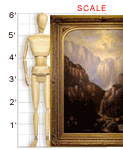From the collection of:
The Filson Historical Society || VAM Home
Carl Christian Brenner (German-born American, 1838-1888)
ANGEL FALLS, 1873
Oil; 69-1/2" X 53"
1985.1.1; Gift of Mary Elizabeth Lawler
The Filson Historical Society
Although the accession record for this work notes that it might be Yosemite Falls, research indicates that there is an Angel Falls in Yosemite National Park. The painting shows monumental cliffs and a waterfall that develops into a river or tributary. Clouds and a blue sky fill the upper portion of the painting. Brenner’s grandchildren donated this painting to the Filson Historical Society.
About the Artist
Artist Carl Brenner was born in Bavaria, Germany, where he studied with Philip Frolig, a minor German Romantic practitioner. He was also trained as a glazier and, like many other craftsmen, was displaced by the revolutions of 1848 in Germany. In 1853, he immigrated to New Orleans, where the arts community was infused with a strong German presence. Brenner worked as a glazier and sign painter before moving to Louisville in 1854. He lived there for the rest of his life, though he did make a trip to California in the early 1870s to sketch Western scenes. There is some evidence that he was associated with American landscape artist Albert Bierstadt.
Brenner exhibited works at the Louisville Industrial Exposition in 1873, the Philadelphia Centennial Exposition in 1876, the National Academy of Design in New York from 1878 to 1886, and the Pennsylvania Academy of Fine Arts from 1881 to 1885. After 1878, he was part of a group of Louisville artists known as Tonalists, who used muted color to evoke mood. His views of the city’s parks and woods were popular items with Louisvillians, and Brenner, wearing an artist’s hat and carrying a staff and paint box, was a familiar sight around town in the late 1870s and early 1880s. Night-time sales of his works in his gas-lit studio were popular social events, raising his prices from about $35 a painting in the 1870s to around $1,000 just before his death.
During his lifetime, Brenner’s paintings also were exhibited in Vienna and California. And he was one of only a few Kentuckians whose work was included in the 1883 Southern Exposition in Louisville. Brenner died in Louisville in 1888. His son Carolus Brenner was also a Louisville artist. (His painting Natural Entrance, Mammoth Cave is also featured in this gallery.)
Classroom Ideas
Discussion: What style is this painting? How has the artist used color? What is the focal point? Compare this painting to Brenner’s later work Winter Scene, also in the Filson Historical Society gallery, as well as other landscapes in the Kentucky Virtual Art Museum.
Activity: Create a landscape, either by working from a photo or by going outside and quickly sketching the composition. Choose colors to convey a mood.
Links
Other examples of Brenner’s work can be found at these sites:
- Speed Art Museum
[www.speedmuseum.org/brenner_n.html] - Ogden Museum of Southern Art
[www.ogdenmuseum.org/collections/from-artist.html?my_artist_id=6464] - Thomas Colville Fine Art Gallery
[www.thomascolville.com/catalogue/brenner/] - Charleston Renaissance Gallery (via Artnet)
[www.artnet.com/Galleries/Artists_detail.asp?G=&gid=525&which=&aid=687608&ViewArtistBy=online&rta=http://www.artnet.com]
The Hesse/Brenner Family Obituaries page at the RootsWeb genealogy site includes a copy of a newspaper article about Brenner and a photo from his funeral.
[homepages.rootsweb.com/~mmhesse/Obits-HesseBrenner.html]
Brenner is included in the Filson Historical Society’s Art of History exhibition.
[www.filsonhistorical.org/decartexhibit.html]
For links to online resources about Albert Bierstadt, check the Artcyclopedia.
[www.artcyclopedia.com/artists/bierstadt_albert.html]


